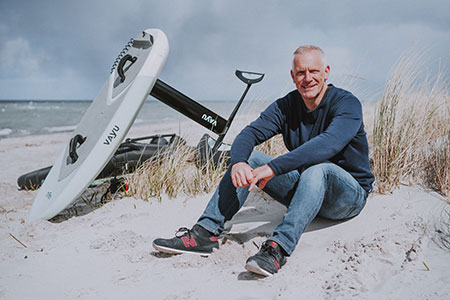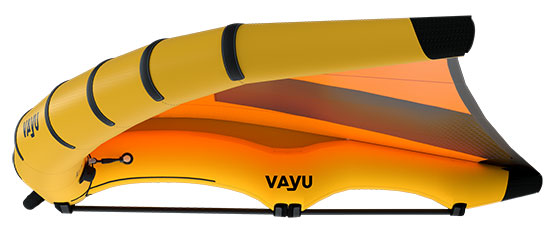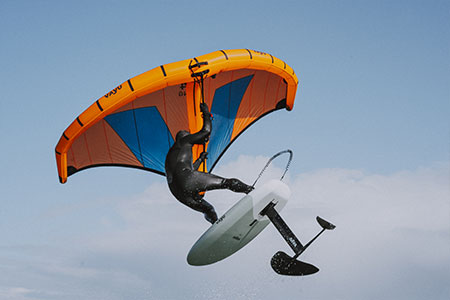Wing and foil brands already exist, but in the race for the best solution between boom and trade, no one has made the race yet.

Philip Horn co-founder of the Kiel-based label “vayu” in Germany, has proposed a new solution. We have spoken with him.
Aloha Philip,
Thank you for taking the time for the Stand Up Magazine. You have been a distributor in surf and SUP sports for years and have now started your own label.
Can you give us a brief history?
During the last lockdown I got totally addicted to the sport and do almost nothing else since then. At the same time there was not much available on the market and also from the brand Fone, which I represented at the time, I could not get suitable boards with footstrap plugs. So we started to design boards ourselves and have them built in Europe to get the right material for the fast development. This quickly developed into a team with which we still work today.
Last week we had an article on the Stand Up Magazine where we counted how many brands there are now that produce wings. We counted quite a bit, I have counted their 40 whereby this number must be corrected slightly upwards.
What do you have to pay attention to as a new brand in order to stand out and survive in a large competitive field?
There are certainly many brands on the market and many offer similar or almost the same concepts, so the first OEM products are also offered by factories, that is, different brands have the same wing only with different design. We wanted to stand out and be innovative from the beginning and I think that is the key to survive and stand out in the market. It reminds me a lot of the kite development, where also the innovative brands with their own designers have prevailed. Certainly, service and distribution also play a big role.
I read in a recent interview with you that you expect the trend to move away from handles to booms and fixed grips. In the interview, however, the train of thought does not come up. Explain to us what your thoughts are on this.

Most brands are working on making the trades stiffer and less flexible so that you have better control of the wing and can always position the wing 100% ideally even during maneuvers (which are becoming faster and more complex). This is not achieved with the actions, but only with a fixed grip solution. In addition, the bars are gentler on the fingers and prevents the joints from becoming inflamed quickly.
Do you see this in all mission areas or in some. If so, in which ones?
In the shaft certainly makes a solution with handles and a wing that is super light makes sense, but again it is important to make the handles as wide and as stiff as possible. But here see a range of application of both variants as possible.
Let’s stay briefly with the question of boom or handles, because I find this very interesting. Please explain your new system with the split boom:
We fiddled around for a long time how to get the trades tight, with foam pads and sent countless different samples to the factory until we came up with the final solution. We have divided the boom and supported the division point by the Mittestrut. The spot is chosen so that you don’t have to reach here with your hand and you can still hold the Wing one-handed. The space in the middle allows you to pack the Wing small and can leave the bar firmly on the Wing.
How are they mounted to the middlestrut ?
The spar is sewn to the middlestrut and then screwed, so you can also change the spar at any time and we also have all parts of the wing as spare parts in stock. It is very important to us to get people back on the water quickly in case of problems.
What’s the coating on these?
The coating is like a windsurfing boom only a little thinner and softer, so in an EVA foam.
What’s the diameter?
Are they 24mm thin so virtually as thin as the thinnest windsurf boom.
What can the industry do to easily introduce newcomers to the sport without scaring people about the foil under the board?
There are several solutions here, on the one hand we have a beginner board, with which you can only mount the mast and additional fins. The board is 90cm wide and with 180 liters it also has enough buoyancy and is very stable. So you can also move with the wing and board without needing a foil. But also the drift stopper is a way to upgrade a SUP board so that you can go back and forth with a board without a foil without drifting.

There are several solutions here, on the one hand we have a beginner board, with which you can only mount the mast and additional fins. The board is 90cm wide and with 180 liters it also has enough buoyancy and is very stable. So you can also move with the wing and board without needing a foil. But also the drift stopper is a way to upgrade a SUP board so that you can go back and forth with a board without a foil without drifting.
With your products: Which set-up should a beginner buy and which one should the ambitious advanced user buy?
My recommendation is a board which has 30-40 liters more buoyancy than your own body weight (example 90 kg person should choose a board with 120-130 l) a wing around the 5-5.5 square meters and a foil with over 2000cm2. The setup fits for 80% of the winds here in Germany in other areas you can safely set the wing size with 4.4, the other components I would leave the same.
Let’s try to look into the future for a moment. Where do you see wingfoiling and wingsports in 5 years?
I think it will become as big or bigger a sport than windsurfing and kiteboarding, and a lot of new people will join. It will certainly become more of a recreational sport than a purely competitive sport.
Is the industry in danger of repeating the same mistakes in wing as in windsurfing?
I hope not, but I think there will certainly be enough brands, like us, to make sure that they act inclusive and bring the sport to many people and make it easy, and not just go for big waves and high jumps. I think more of the SUP sport than the windsurfing sport, here it has also succeeded in captivating many people to the sport.
Thank you very much for your time and all the best.
Thank you and see you on the water.
